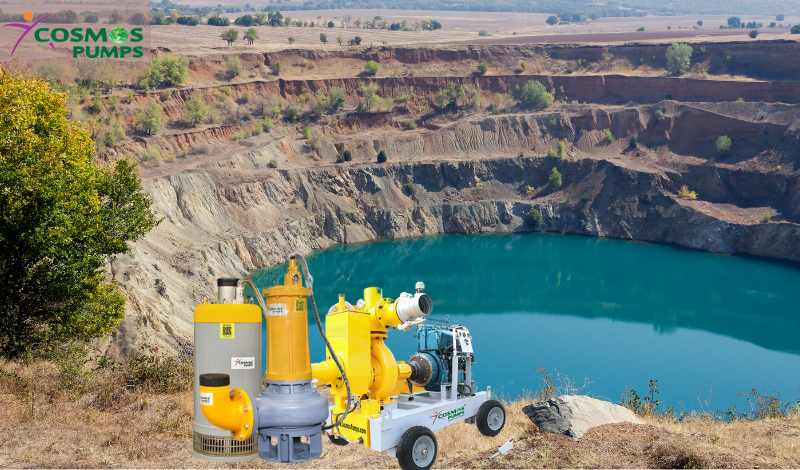
Priyanka Gunglani
12-04-2024
A suitable and enough pump is essential to the functioning of the mine since choosing a mine dewatering pump is key to extracting valuable minerals. Cosmos Pumps has contributed its knowledge in this blog post to assist you in choosing the best mine Dewatering Pumps Nigeria.
What Does Dewatering Entail?
Dewatering is the process of removing surface or groundwater from a location, usually a mining or construction site, to lower the water table and allow for safe and effective operation. Dewatering is typically a continuous process on a mining site and is essential to getting to subterranean minerals. Before beginning any subsurface excavation operations, such as digging or drilling, dewatering is necessary on construction sites. Water can be a problem for excavation operations, and excessive water levels can negatively impact worker safety, project efficiency, and financial viability.
What is a Dewatering Pump?
A dewatering pump is positioned below the groundwater level to reduce and maintain the water level at this level. Money can be saved at mine sites by installing mine dewatering pumps. Better working conditions minimize downtime, dry ore and waste material are lighter and easier to carry, and greater structural integrity of the work area enhances worker safety.
What Information is Necessary to Choose a Dewatering Pump?
There is a chance of flooding out and consequent loss of equipment and operating time if the chosen mine dewatering pumps are too tiny or there are not enough of them. On the other side, the motor may burn out from too many starts per hour if the dewatering pump is too big. There wouldn’t be enough time for the motor to cool down before starting again. Suction cavitation, which happens when the pump is “starving” for water, is another possibility for the pump.
As a result, Cosmos Pumps advises taking into account the following factors when choosing mine dewatering pumps:
Static head:
As with any pump, you must ascertain the static head that it must overcome. The necessary flow will not be realized if the pump is unable to generate sufficient pressure to cross the vertical distance.
Flow rate:
How much water must be appropriately removed to keep the mine dry? Think about the type of pump that will work best for the application at this point. How long is the suction line if the pump is self-priming? Suction cavitation can be prevented if the size of your suction line is larger than or equal to the size of the suction or input port.
Depth of the subterranean sump:
The static pressure in the system that is available to drive the water into the pump is known as the available net positive suction head, or NPSHa. The NPSHa is significantly influenced by the type of pump chosen. Numerous factors that are pertinent to the particular environment have an impact on the NPSHa. These factors may include:
- pump’s elevation above sea level
- temperature
- specific gravity
- static differential between the pump’s suction and the water level
- length of the suction pipeline
You have to take into account the necessary pressure that the mine dewatering pumps must operate at. Each pump must meet a minimum net positive suction head (NPSH) requirement based on its operational duty point to guarantee continuous flow. Consequently, while choosing a dewatering pump, the net positive suction head required (NPSHr) must be compared to the net positive suction head available (NPSHa). To minimize the possibility of suction cavitation, Cosmos Pumps advises that NPSHa always be greater than NPSHr, ideally with a safety margin of one to 1.5 meters.
Pumping system capabilities:
The type of dewatering pumping may cause changes in the pumps’ efficiency. The pump’s performance may deviate from the best efficiency point when wear or other causes cause the pressure to change (BEP).
Flooding out or the loss of vital equipment and operating time could happen if the mine dewatering pumps used are too tiny or there aren’t enough of them. On the other hand, an excessively big pump may cause the motor to overheat from frequent starts throughout the hour. The engine will have no time to cool off before starting again, and the pump could encounter suction cavitation as it is starving for water.
This is why it is important to get in touch with us at Cosmos Pumps so that we can guide you on which pump will suit your needs the best. Contact us today.
- Categories
- Dewatering Pumps (23)
- News (1)
- Submersible Pumps (14)
Latest Post
- Applications, Features, and Selection Tips for Submersible Dewatering Pumps
- Knowing And Choosing Dewatering Pumps For Mines
- Key Considerations for Submersible Pump Selection
- Advantages and Disadvantages of Submersible Pumps
- Dewatering in Dubai: How to Optimize Water Control for Construction Projects
- Cosmos Pumps Introduces The Giant Dewatering Pump